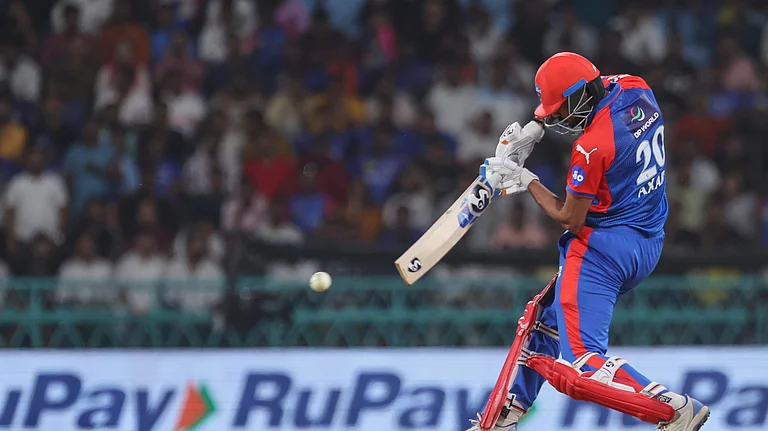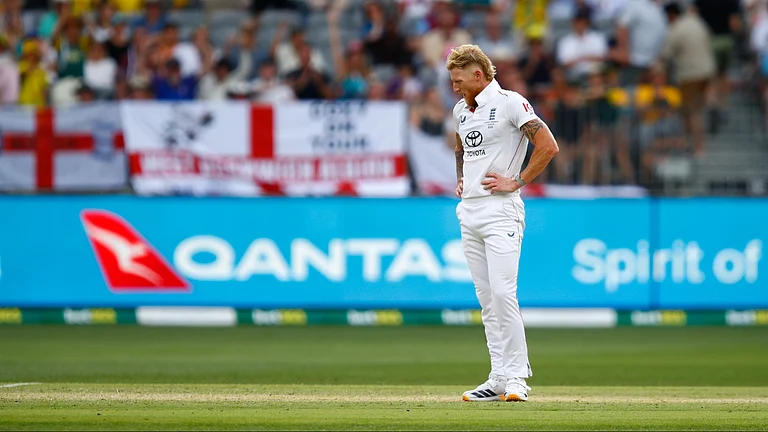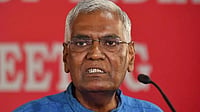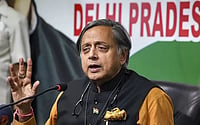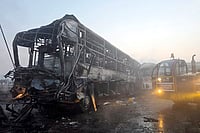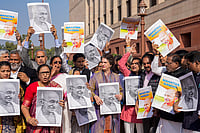AND then, the mother-statistic of them all, which engenders these shockers—by the turn of the century, India will have well over a billion people. Don't shrug these numbers away as shocking statistics that acquire meaning only in the demographer's domain. Nor dismiss them as alarming arithmetic meant to enliven tedious analyses of the country's population problem. Because these numbers touch your life. These quantities affect the quality of your existence. Multiplying its struggles and dividing its opportunities.
Adding to the anxieties of a distressed parent who hopes his daughter will beat over two lakh applicants to one of the mere 3,000 seats in India's top management institutes. Subtracting from the upwardly-mobile executive's possibility to hire a two-bedroom apartment in Worli, Bombay, despite his Rs 15,000 monthly rental allowance. Minimising a Delhiite's chances of travelling down to Calcutta during Durga Puja without having to wait hours in interminable queues at the advance train ticket booking counter. Taking away from the meagre quantity of boiled ragi (millet) that a malnutritioned child consumes in
Orissa's Raigarh, the poorest district of the country. Yes, trouble is breeding in India. In fact, breeding is the trouble. Multiplying millions are hankering for their share in the nation's supplies of food, safe drinking water, housing, healthcare facilities and education. Suspend that seductive image of a youthful India poised to be the next Asian Tiger—for too many Indians, deprivation is the only reality. "What else to expect in a country that has 16 per cent of the entire world's people with just about two per cent of its land! We've added two Americas since Independence without even half its resources. Obviously, there's going to be a fight over the share of amenities," says Ashish Bose, population economist at the Institute of Economic Growth. To hammer the point further, Prof Sumati Kulkarni, head of the Department of Development Studies at the International Institute for Population Sciences, adds: "Sheer numbers are an extreme strain on resources. Because human beings cease to be assets without sizeable investment."
Well, according to the 1996 UNDP report, India invests only $14 per person annually in health and education unlike South Korea's $160 and Malaysia's $150. The sum is obviously too insufficient to impact the 554 million identified as 'capability poor', measured by their capability to be well-nourished, to effect healthy reproduction and pursue education. Much less the other 29 per cent who are below the poverty line and earn less than Rs 1,290 per annum. Of them, 20 per cent are labelled 'poorest' and earn a paltry Rs 537 a year. Meaning, some earn barely enough to buy nothing more than four kilograms of potatoes in a month. Some earn even less.
The statistics cry out for investment that would render them and their children less of a liability for the nation. For a better quality of life. Voicing this desperate plea, Bhanu Pratap who wraps his perfectly able limbs with dirty bandages every morning to beg at the capital's busy Moolchand crossing, says: "Why doesn't the Government help my family live well instead of wasting its time asking me not to have five children who help me earn? They are keeping me alive, not the sarkar." S. Lakshmanna of Paadigenahalli village in Karnataka's Kolar district echoes the sentiment: "I had four children to have two sons. I married off one daughter. But I don't send the boys to school. I need them to work in the field.
His decision illustrates the population-poverty paradox. It's both the consequence of and the reason for the population growth. Having produced many children for sons to combat his family's growing needs in an area that has more people in the employment fray by the day, Lakshmanna is forced to keep them out of school to supplement his household income. In turn, unlettered and ignorant, they will inherit their father's lot and, like him, opt to have as many sons as are needed to work for sustenance.
Says Dr Saroj Pachauri, regional director for South-east Asia at the Population Council: "Ironically, a huge family size is the poor man's only way to combat the population boom. Having a large family is his only means to a larger share of the national resources for his family." D. Banerjee, community health specialist, agrees: "Population growth is the ultimate weapon in the hands of the oppressed to snatch their rights from the oppressors."
In which case, the story of the terrible disparities between rural and urban India that statistics narrate could mean that the Indian Republic has little chance of living happily ever after. About 90 per cent of rural households have no access to any form of toilets and over 60 percent have no electricity. This, when the urban centres are caught up with discussing the nuances of uplinking rights and Yankee fried chicken. This, four years away from the 21st century.
But out of the statistics books, the situation is even more stark. Attending to hordes of patients who swarm into the Primary Health Centre at Jani village in Uttar Pradesh's Meerut district, medical officer-in-charge Dr A.K. Goel complains of the absurd allocation of two doctors and 28 auxillary-nurse-midwives (ANMs) for the 1.5 lakh population under the centre's care. "I'm sure we add to the impressive statistics of the health system in the country. Check hard and you'll even find a statistic saying we have an operation theatre here. But does anyone care that we get barely two hours of electricity a day," he fulminates. Adding angrily that a generator sent recently by the Health Ministry was accompanied with express instuctions "for exclusive use for sterlilisation surgeries because it's a part of the fund for family planning."
Meanwhile, thousands of miles away, in Bihar's Katihar district, deprivation takes on even more dangerous implications. In a country that supplies an average of 2,395 daily calories per person, as against the WHO minimum of 2,400 to remain above the poverty line, the Katihar residents manage much less. Prompted by the hunger pangs of their children, many local dais (midwives) confess to slaughtering infant girls at birth for a pittance. "My family is huge and there are no jobs here for my husband. Better kill someone else's child than see mine die for want of food. And these girls would lead lives like death if I didn't put them to sleep," justifies Phutkari Devi, a middle-aged dai . Explaining the 'attitude', Anilla Rai of Katihar-based Bal Mahila Vikas, an NGO working towards eradicating infanticide, says extreme poverty causes large family sizes and gender discrimination. "They'd be different if they were in a city. At least, they'd have two square meals." Millions of villagers, obviously, believe in the same myth. Delhi sees an influx of over 15 lakh people every year, of whom at least three lakh stay on. If fortunate, to live in a squalid slum and earn barely enough to survive.
Like the Thakurs who came from Chanwa, Bihar, to look for a better life in Bombay. Today, they live in a pokey dwelling in Andheri, a western suburb in the megapolis. In their sardine tin of a shelter, they work as dhobis and earn about Rs 40 a day. "We've had five children in four years, including a set of twins. Finally the youngest is a son," says Manju Thakur. "Vegetables are so expensive. Life is difficult for the poor in cities," she adds.
Indeed it is. Bursting at their seams, most metros have little to offer to the great influx of people by way of accommodation. The going rental rate for a jhuggi near south Delhi's Mandakini Enclave has risen to Rs 800. Rundown jhopdas (shacks) in crowded Bombay, which has 35 per cent of its population packed up in slums, don't come any cheaper than Rs 500. Small tenements in the more 'affluent' slums are not less than Rs 900 a month.
"The tremendous gap between the demand for housing and availability of housing stock has disturbed the rental market alarmingly," says Om Prakash Mathur, Professor of Housing and Urban Economics at the National Institute of Public Finance. The increasing demand has landlords seeking and getting over Rs 40,000 in posh metro localities. In turn, often pushing corporate professionals to live in areas which a clerk's salary could afford till the other day. At the bottom of the chain, some child sleeps under the open sky. "Undoubtedly, the burgeoning population is largely responsible for this, but faulty Government policies have played their part too. Considering we don't have a land crunch yet, we could have done better. But thanks to the Land Acquisition Act and the Land Regulation Act, the Government has just not been releasing land," Prof Mathur analyses.
Dr Shashanka Bhide of the National Council for Applied Economic Research is also a critic of the faulty policies that have aggravated the population problem. Managed well, the economist feels, India could have utilised its large human capital to accelerate its growth. "Our growth in terms of facilities and infrastructure hasn't been commensurate with our population increase. That's made the problem more dreadful," he avers.
But in a country of millions, there are no dearth of contrary views. Washerwoman Rajeswari in Madras' Saidapet area, for instance, has an interesting counterpoint. She reckons that the Government's sheer apathy towards building good hospitals, providing employment and reining in galloping prices have become contraceptives for women like her today. "Women like us can't afford to have children like our mothers did in the good times!" she reasons.
A valid opinion. A good reason to plan one's family. Not many decisions to have a small family, of course, are made with an eye on the country's census figures. Controlling the population is quite simply no one's high-priority area.
Explains 27-year-old Lipika Sen, copywriter at Triton, who is in no hurry to have children after four years of marriage: "It's been a matter of personal choice. Hardly the outcome of pondering over India's population." Hyderabad-based exporter Anand Babu too laughingly dismisses all links between his decision to have only one child and India's burgeoning numbers. He says with a chuckle: "It was no great contribution towards solving India's population boom. Simply that both my wife and I were well above 30 before we settled down in our careers and reasoned that it was too late to have more children."
Birth control, as demographic trends from the developed countries indicate, ought to become a matter of personal choice if population is to be stabilised. For a progressive few in urban India, it already seems to have become that. But it will take long before the "small family, happy family" concept becomes an inherent part of the Indian psyche. Surely, it doesn't help to have over 95 per cent women in India know of contraception if only 41 per cent use it.
The onus is on our Family Planning programme, which has never really taken off. Target-ridden, its accomplishments have been limited to dry statistics in the record books. Ridiculously, the '80s registered a doubling of the number of people using contraceptives but the birth rate remained near stagnant. Finally, last month, after three decades of alleged figure-fudging and sterilising people past child-bearing age, the Family Planning programme discarded its focus on attaining contraceptive targets and decided to concentrate on Reproductive and Child Health (RCH).
It doesn't matter that the noble aims of the new RCH programme have its implementors at the grassroots baffled. Not many seem to have a clue how to render actionable all the lofty slogans—quality care, sustained health benefits to mother and child, acount-ability to woman, child and community, emphasis on a full range of family planning services and gender-sensitive equality for women in health. Asks Reeta Kanwar, a confused ANM at a primary health centre in Ghaziabad district: "This new thing means now we don't pay people any money to get sterilised, is it? So, now family planning is like the anti-malaria, anti-leprosy, anti-polio drive? We just have to talk to mothers about breast-feeding and all that, huh?"
Kanwar's confusion, in fact, is a telling comment on the pendulum swings that the Family Planning programme has taken from time to time. Dangling between 'sensitive' and 'savage'. It's either been the Maternal Child Health, MCH, the focus of 1951, and its latest avatar, RCH. Or, the body-snatching sterilisations of the Sanjay Gandhi days which now find face in the Swaminathan Committee's draft policy on a national population policy. It recommends that "battalions of the Indian Army which are involved in helping overcome environmental degradation may be deployed wherever feasible to serve the cause of health and population stabilisation."
But optimism dies hard. Some point out that the population growth rate has actually registered a .08 per cent decline in the last decade. Says Shaileja Chandra, additional secretary in the Health Ministry: "With the resurgence of malaria, tuberculosis and cholera we have been doubly burdened. Also, we've realised that some of the goals set in the 1983 health policy—like the small family size—are unrealistic. So we're going in for a revamp. " Given the right moves, she reckons enough leverage can be created for a turnaround. Wasim Zaman, United Nations Population Fund representative for India, concurs: "This country will certainly overcome the population problem if only there was an opening up of the boxes—in ministries, in bureaucracies, in gender equations and in minds." Valid argument. The attack has to be many-pronged. If the education ministry imparted sex education to all adolescents and the urban development ministry ensured that each man will have a roof over his head in old age, then the birth rate would perhaps come down.
But this can only be parented by political will and concern. Unfortunately, succeeding governments have treated the family planning programme as a stepchild. Shying away from the backlash that a Sanjay Gandhi-like approach might bring about. Skirting the problem because effective intervention would mean tackling minorities-related figures that show total fertility rate amongst Muslim women is 4.4 as compared to the Hindu 3.3. Showing no particular interest in placing the issue on the political agenda. But never ceasing to pay lip service.
Admitting that most parties are loath to deal with the problem due to "religious issues", Congress MP Najma Heptullah suggests that the Family Planning programme be renamed Population Control Programme. Senior CPI leader M. Farooqi emphasises that development is the only answer to rising numbers. He scores a political point: "The Congress has only spent time amassing wealth through various scams without doing anything to alleviate poverty." Hardly surprising that BJP leader and former finance minister Yashwant Sinha takes a similar line. "We're the only party which mentioned population as a priority area in its manifesto." Well, so long as the votebanks don't shrink, who cares that the population is growing...
To crowd. And overcrowd. Till, on August 15 in AD 2000, India's capital has nearly 10,000 people on every square kilometre. Scrambling for space. Food. Water. Education. And finding no reason to believe in yet another set of promises being made from the ramparts of the Red Fort.







